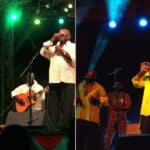 The music of Dominica plays an important role in the social and culture life of the Antillean island of Dominica. Popular music is widespread, with a number of native Dominican performers gaining national fame in imported genres like calypso, reggae, soca, zouk and rock and roll. In addition, Dominica’s own popular music industry has created a form called bouyon, which combines elements from several styles and has achieved a wide fanbase in Dominica, especially the group WCK (Windward Caribbean Kulture). Native musicians in various forms, like reggae (Nasio Fontaine, Brother Matthew Luke), soca (Derick St. Rose-De Hunter, Young Bull), zouk (Ophelia Marie, Exile One) and calypso (Lazo, The Wizzard) have also become stars at home and abroad.
The music of Dominica plays an important role in the social and culture life of the Antillean island of Dominica. Popular music is widespread, with a number of native Dominican performers gaining national fame in imported genres like calypso, reggae, soca, zouk and rock and roll. In addition, Dominica’s own popular music industry has created a form called bouyon, which combines elements from several styles and has achieved a wide fanbase in Dominica, especially the group WCK (Windward Caribbean Kulture). Native musicians in various forms, like reggae (Nasio Fontaine, Brother Matthew Luke), soca (Derick St. Rose-De Hunter, Young Bull), zouk (Ophelia Marie, Exile One) and calypso (Lazo, The Wizzard) have also become stars at home and abroad.
Like the other Francophone musics of the Lesser Antilles, Dominican folk music is a hybrid of African and European elements. The quadrille is an important symbol of French Antillean culture, and is, on Dominica, typically accompanied by a kind of ensemble called a jing ping band. In addition, Dominica’s folk tradition includes folk songs called bélé, traditional storytelling called kont, masquerade, children’s and work songs, and Carnival music.
Until the late 1950s, the Afro-Dominican culture of most of the island was repressed by the colonial government and the influence of the Roman Catholic Church, both of which taught that African-derived music was evil, demonic and uncultured. This perception changed in the mid- to late 20th century, when Afro-Dominican culture came to be celebrated through the work of promoters like Cissie Caudeiron.
Dominica’s terrain is rugged, which has fostered distinct regional traditions. The northern, eastern, southern, western and central parts of the island are music areas. The villages of Wesley and Marigot are also unique in their preservation of English language and music rather than the more French-based styles of the rest of the island.
Dominican folk music is an oral tradition, learned informally through watching others perform. As of 1987, most performers of traditional music were either over fifty years old or under thirty-five, which indicates an ongoing revival of previously declining traditions. Music is evaluated based on both characteristics of the music, such as complex syncopated rhythms, as well as social factors, such as the ability of the performers to improvise and respond to their surroundings and to keep the audience excited and participating in the music.
Characteristics of Dominican music include the use of call and response singing, clapping as a major part of rhythm and lyrical, dance and rhythmic improvisation. Lyrics are almost all in French Creole, and are traditionally sung by women (chantwèl), while the instrumental traditions are predominantly practiced by men. Drums, generically known as lapo kabwit, are the most prominent part of Dominica’s instrumental tradition.





